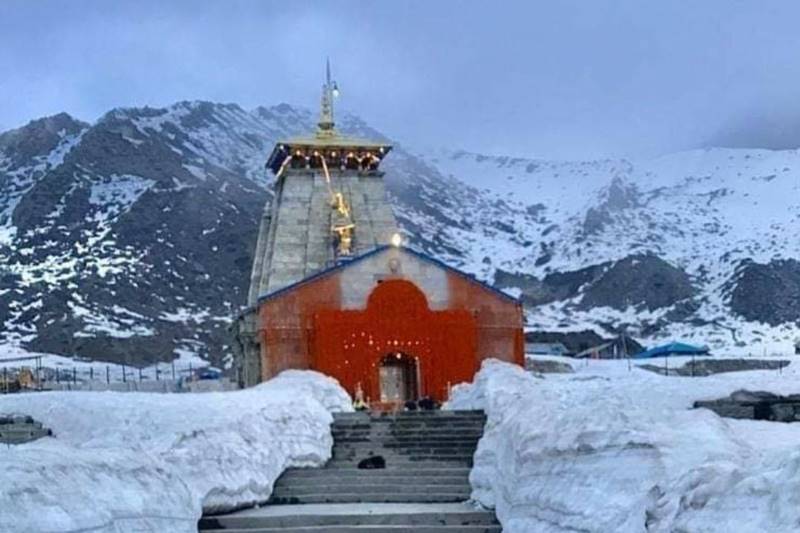Kedarnath temple is located in Uttarakhand, India. The temple is a miracle temple. It is said about this temple that it does not face any problem. This temple built by the Pandavas was renovated by King Bhoj after Shankaracharya. In 2013, all the area around the temple was destroyed in the terrible devastation. But even in that terrible storm and flood, the Kedarnath temple stood with its full glory. It is the biggest miracles for the whole world. Even today people believe that this miracle was done by God. It was the power of Mahadev that saved the Kedarnath temple even during the Holocaust. Even today lakhs of devotees come here to visit. Kedarnath means lord of mountains (Kedar) . It is among the most mystical shrines across the world. It is known as living Shiva and devotees treat him as a living deity with all needs. This temple was first built by the Pandavas behind the existing temple, but due to the hit of time, this temple disappeared. Then this temple was built by Adi Shankaracharya who was born in 508 BC and went to Dehatag in 476 BC. His samadhi is behind this temple. Its sanctum sanctorum is relatively ancient, believed to be around the 80th century. The temple was first renovated by King Bhoj of Malwa in the 10th century and then in the 13th century.
The temple of Kedareshwar Jyotirlinga, one of the 12 Jyotirlingas of the country, is situated on the peak of Kedar of Giriraj Himalaya in the Indian state of Uttarakhand.
In Kedarnath Dham, on one side about 22 thousand feet high Kedar, on the other side 21 thousand 600 feet high Khetkund and on the third side the mountain of Bharatkund, 22 thousand 700 feet high. Not only 3 mountains but also a confluence of 5 rivers is here - Mandakini, Madhuganga, Kshirganga, Saraswati, and Swarnagouri. Mandakini, a tributary of Alaknanda is still present in these rivers. On the side of this is Kedareshwar Dham. There is heavy snow in winter and tremendous water in rain.
This temple is built by adding large and strong stones of the brown color of cut stones. The 85-foot-high, 187-foot-tall and 80-foot-wide temple walls, standing on a 6-foot-high platform, are 12 feet thick. It is a wonder how the temple would have been brought by bringing such heavy stones to such a height and carved it? Especially how was this giant roof placed on the pillars? Interlocking techniques have been used to connect stones to each other.
The temple gates are closed during the winter season on the second day of the Deepavali Mahaparva. The lamp keeps burning inside the temple for 6 months. The priests close the honors boards and take the Deity and punishment of God to Ukhimath under the mountain for 6 months. After 6 months, the doors of Kedarnath open in May, then the journey to Uttarakhand begins. No one lives in and around the temple for 6 months. But surprisingly, the lamp also keeps on burning for 6 months and worships continuously.
Do:
-
Do pray your Ishta Devata before pilgrimage to Temple.
-
Do contact Temple Devasthanam information centre for enquiry, temple information and for Pooja details etc.
-
Do reserve your travel and accommodation at Temple well in advance.
-
Do bath and wear clean clothes before you enter the temple.
-
Do concentrate on God and Goddess inside the temple.
-
Do maintain silence and recite Om Namahsivaya or your Istamantram to yourself inside the temple.
-
Do observe ancient custom and traditions while in Temple.
-
Do respect religious sentiments at Temple.
-
Do deposit your offerings in the hundi only.
Don't s:
-
Do not come to Temple for any purpose other than worshipping of God and Goddess.
-
Do not smoke at Temple.
-
Do not consume alcoholic drinks at Temple.
-
Do not eat non-vegetarian food in the Kshetram.
-
Do not approach mediators for quick Darshanam. It may cause inconvenient to others.
-
Do not carry any weapon inside the temple.
-
Do not wear any head guards like helmets, caps, turbans and hats inside the temple premises.
-
Do not perform Sastanga Pranama inside the Sanctum Sanctorum.
-
Do not take much time while performing Sparsa Darshanam to God in Garbhagriha.
-
Do not buy spurious prasadams from street vendors.
-
Do not encourage beggars at Temple.
-
Do not spit or create nuisance in the premises of the temple.
Do:
-
Do pray your Ishta Devata before pilgrimage to Temple.
-
Do contact Temple Devasthanam information centre for enquiry, temple information and for Pooja details etc.
-
Do reserve your travel and accommodation at Temple well in advance.
-
Do bath and wear clean clothes before you enter the temple.
-
Do concentrate on God and Goddess inside the temple.
-
Do maintain silence and recite Om Namahsivaya or your Istamantram to yourself inside the temple.
-
Do observe ancient custom and traditions while in Temple.
-
Do respect religious sentiments at Temple.
-
Do deposit your offerings in the hundi only.
Don't s:
-
Do not come to Temple for any purpose other than worshipping of God and Goddess.
-
Do not smoke at Temple.
-
Do not consume alcoholic drinks at Temple.
-
Do not eat non-vegetarian food in the Kshetram.
-
Do not approach mediators for quick Darshanam. It may cause inconvenient to others.
-
Do not carry any weapon inside the temple.
-
Do not wear any head guards like helmets, caps, turbans and hats inside the temple premises.
-
Do not perform Sastanga Pranama inside the Sanctum Sanctorum.
-
Do not take much time while performing Sparsa Darshanam to God in Garbhagriha.
-
Do not buy spurious prasadams from street vendors.
-
Do not encourage beggars at Temple.
-
Do not spit or create nuisance in the premises of the temple.
